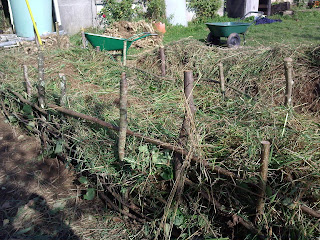Before we moved to Normandy, I probably would've found it difficult to listen to anyone tell me about appropriate wood felling, coppicing without wincing at the thought of a tree being simply chopped down. Regardless of the intentions of the person. But to manage your primary energy source, you must become a woodsman. By learning how to properly coppice, wood can become a fully sustainable energy source.
This small area in our woodland is about 20 metres across and 60 metres from top to bottom. In order for the previously fell trees to properly coppice we need to remove as many of the big "blocking" trees otherwise the coppicing won't really take place and it would have all been a waste of time. Our target trees today were these two above dead centre of the picture.
What we are trying to do is remove all the canopy so that light can get to the forest floor. This time of year there is little to no foliage and plenty of light gets down, but nothing is growing. Once spring comes it's a rush to suck up that beautiful life-giving yellow warm stuff from the sun. In the picture above, pretty much all the trees will need to be removed in order to put this area into coppice rotation.
So two old fellas start by making a wedge in our target tree. We want to encourage to fall to the right, down the hill and between some trees at the bottom... fingers crossed.
Then we get out the cross-cut saw, this one is 4-feet across and make a cut slightly above the centre point of your wedge. You continue to cut until the tree starts to make cracking noises, then remove yourself pretty quickly and watch your tree fall exactly where you thought...
On this occasion you can see the tree did in fact fall down slope and between the trees, ding, ding, ding!
The second tree offered us a rare opportunity to retreat from the tree, it was teetering and ready to fall, grab the phone and film it fall... EXACTLY where you hoped it would...
Then have a well-earned cup of tea.
And enjoy the silence... turn up the sound and you may just hear the stream at the bottom of the valley. Oh and by the way volunteers are always welcome.























































